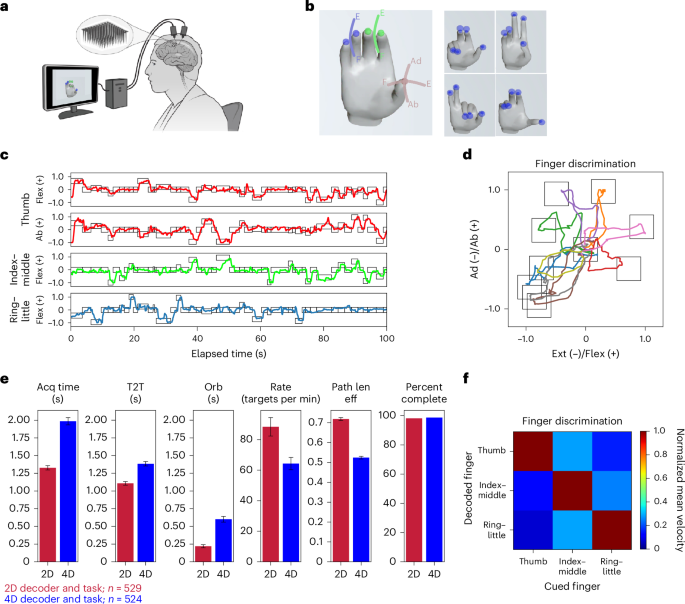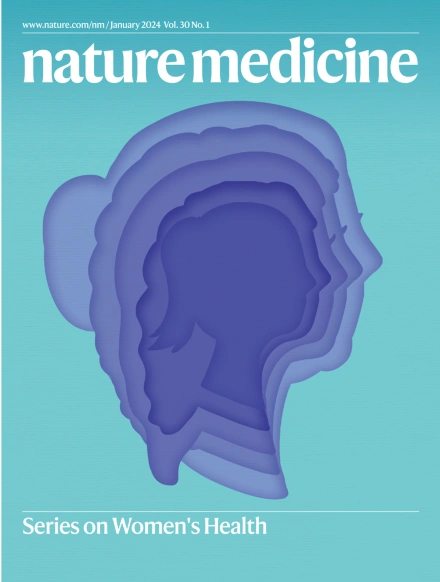一个高性能的脑机接口,用于手指解码和瘫痪患者的四轴飞行器游戏控制
IF 58.7
1区 医学
Q1 BIOCHEMISTRY & MOLECULAR BIOLOGY
引用次数: 0
摘要
瘫痪患者对同伴支持、休闲活动和体育活动的需求未得到满足。普通人群中的许多人依靠社交媒体和大型多人视频游戏来满足这些需求。我们开发了一种高性能的,基于手指的脑机接口系统,可以连续控制三个独立的手指群,其中拇指可以在两个维度上控制,总共有四个自由度。该系统在一名因脊髓损伤而四肢瘫痪的人类研究参与者中进行了连续试验,要求手指到达并抓住目标,平均每分钟获取76个目标,完成时间为1.58±0.06秒,尽管解码自由度增加了两倍,但与之前的动物研究相比,该系统的优势明显。更重要的是,手指的位置被用来控制一个虚拟的四轴飞行器——这是参与者的第一恢复优先级——使用大脑-手指-计算机接口,允许灵活地绕过固定和随机环形障碍物。与会者表达或展示了一种使能感、娱乐感和社会联系感,解决了瘫痪患者的许多未满足需求。本文章由计算机程序翻译,如有差异,请以英文原文为准。


A high-performance brain–computer interface for finger decoding and quadcopter game control in an individual with paralysis
People with paralysis express unmet needs for peer support, leisure activities and sporting activities. Many within the general population rely on social media and massively multiplayer video games to address these needs. We developed a high-performance, finger-based brain–computer-interface system allowing continuous control of three independent finger groups, of which the thumb can be controlled in two dimensions, yielding a total of four degrees of freedom. The system was tested in a human research participant with tetraplegia due to spinal cord injury over sequential trials requiring fingers to reach and hold on targets, with an average acquisition rate of 76 targets per minute and completion time of 1.58 ± 0.06 seconds—comparing favorably to prior animal studies despite a twofold increase in the decoded degrees of freedom. More importantly, finger positions were then used to control a virtual quadcopter—the number-one restorative priority for the participant—using a brain-to-finger-to-computer interface to allow dexterous navigation around fixed- and random-ringed obstacle courses. The participant expressed or demonstrated a sense of enablement, recreation and social connectedness that addresses many of the unmet needs of people with paralysis. A finger-based brain–computer interface was developed for a person with tetraplegia to allow him to fly a virtual quadcopter, an innovation that can lead to improved social connectedness, recreation and a sense of enablement.
求助全文
通过发布文献求助,成功后即可免费获取论文全文。
去求助
来源期刊

Nature Medicine
医学-生化与分子生物学
CiteScore
100.90
自引率
0.70%
发文量
525
审稿时长
1 months
期刊介绍:
Nature Medicine is a monthly journal publishing original peer-reviewed research in all areas of medicine. The publication focuses on originality, timeliness, interdisciplinary interest, and the impact on improving human health. In addition to research articles, Nature Medicine also publishes commissioned content such as News, Reviews, and Perspectives. This content aims to provide context for the latest advances in translational and clinical research, reaching a wide audience of M.D. and Ph.D. readers. All editorial decisions for the journal are made by a team of full-time professional editors.
Nature Medicine consider all types of clinical research, including:
-Case-reports and small case series
-Clinical trials, whether phase 1, 2, 3 or 4
-Observational studies
-Meta-analyses
-Biomarker studies
-Public and global health studies
Nature Medicine is also committed to facilitating communication between translational and clinical researchers. As such, we consider “hybrid” studies with preclinical and translational findings reported alongside data from clinical studies.
 求助内容:
求助内容: 应助结果提醒方式:
应助结果提醒方式:


